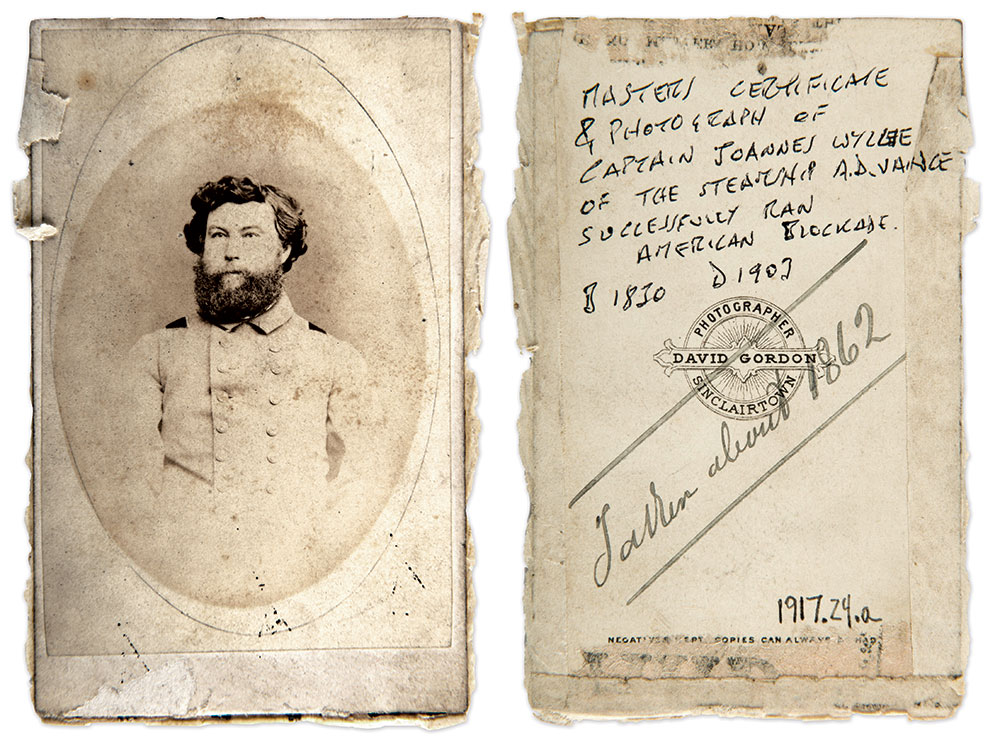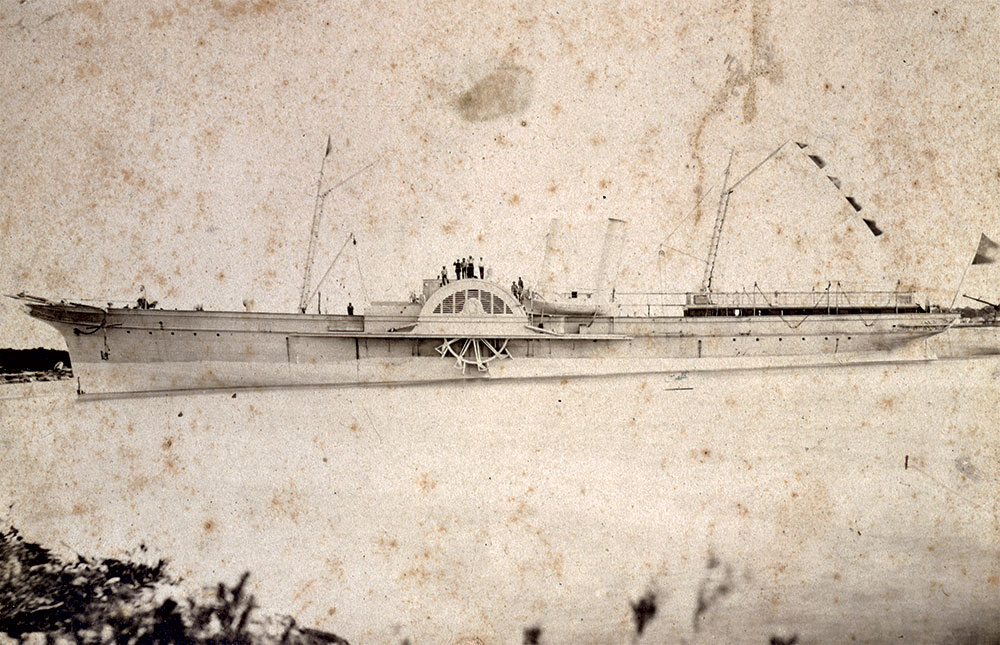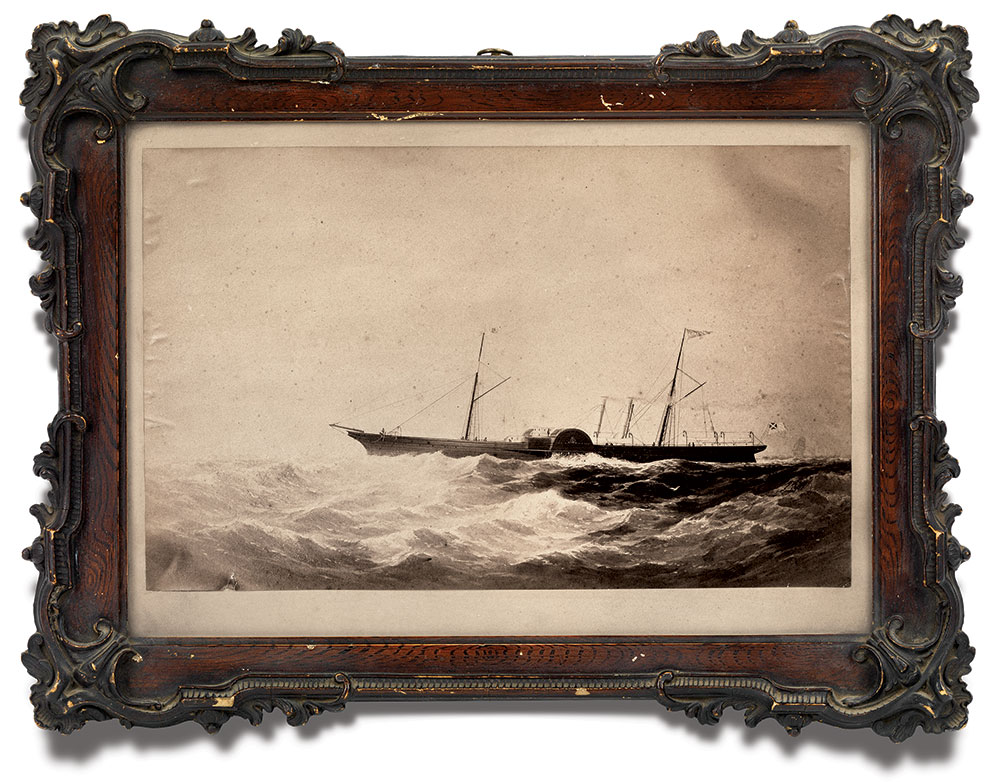By John F. Messner
The steamer Ad-Vance slipped out into the Atlantic from Cape Fear on the night of Sept. 9, 1864, and made its way towards a line of lurking blockaders. The ship’s captain, Joannes Wyllie, worried that bellowing black smoke from the two smokestacks would give away his position. Forced to use inferior coal by the Confederate Navy, who had confiscated the better steam coal for the Tallahassee, the sleek runner was not only hampered by this visible sign, but also with reduced top speed caused by the poor fuel.
Sure enough, a Union warship spotted the great plume and gave chase. Nine hours later, Capt. Wyllie surrendered to the master of the Santiago de Cuba, a large steamer that could not have hoped to keep up with the Ad-Vance in a fair race. It was end of the Ad-Vance’s career as a blockade-runner, which to that point had made 15 successful runs in and out of Wilmington, N.C. So too would it be the end of Wyllie’s connection with the vessel, one that had started on May 21, 1863, when the then named Lord Clyde had left the River Clyde in Scotland. Wyllie was in command on that day, and remained a member of the crew for the entire time that the former Irish Sea ferry would serve as a runner.
The history of the Ad-Vance, one of the most successful runners of the war, has been well documented. Yet the role of Joannes Wyllie has only recently been fully uncovered. Born in 1828 in the Scottish Borders, Wyllie only went to sea at the age of 24 after previous careers as a gardener and teacher. Ten years sailing the waves of the world’s oceans followed, and in August 1862 he became a qualified master and soon began his role as a runner.
He first commanded the screw steamer Bonita, which left Liverpool on Sept. 7, 1862, with plans to run to Wilmington. Yet by the time it made Nassau, the Union blockade had strengthened, and the Bonita was deemed too large and slow to attempt the run. On its return voyage, three agents from North Carolina were aboard as passengers bound for England, and tasked with purchasing supplies as well as a steamer to transport them. It is here where Wyllie’s connection with the Ad-Vance began, as Wyllie’s next employment would be for the state of North Carolina as commander of its newly purchased steamer.
Though it is now known Wyllie was at the helm from Day One, his role on the Ad-Vance was only hinted at in official documents and published histories. Sometimes mentioned as the “sailing master,” his biography was almost a complete mystery with contradictory descriptions listed in contemporary sources. Some labelled him Scottish; others English, while the spelling of name had multiple variations. These sources mentioned him as an officer on the runner, but his exact role on the vessel had never been fully explored.
This changed after research into the history of an oil painting of the Ad-Vance was conducted for a display at the Riverside Museum in Glasgow, Scotland. Featuring ship models of Clyde built runners, a cotton dress of the period and an Enfield rifle, the display opened in 2015 to coincide with the 150th anniversary of the end of the war. The painting, by famed English maritime artist Samuel Walters and once owned by Wyllie, was donated to Glasgow Museums in 1917 by his nephew. Though it hung in the city’s art gallery for a time as a fine example of maritime design, it soon moved away from the public eye into the dark museum storeroom where it sat for decades.

Along with the painting came a carte de visite and Wyllie’s Master’s certificate. Like the painting, both objects were stored away in file cabinets and lay hidden for almost 100 years.
The carte of Wyllie is the only confirmed photograph of the man. It was taken in Wyllie’s hometown of Sinclairtown, Fife, located north of Edinburgh across the River Forth. Photographer David Gordon had set up his studio in the town sometime in first half of the 1860s, later moving to bigger premises in Cupar, Fife, by the end of the decade.
The exact date of the photograph is not known, but on the reverse written diagonally across the card is “Taken about 1862.” This inscription, in ink, may have been in Wyllie’s own hand and added sometime before his death in 1902. Other handwritten items, including details of the donation and the unique museum accession number, were written by museum employees after 1917.

The photograph features a young Wyllie, who, if the date of 1862 is correct, was 34 years old. This year is significant to his career, as he had just passed the master examination, only months away from his connection to the Civil War. This would seem a perfect time to sit for a photograph, with the honor of a newly passed master still fresh and possible dangers in a conflict soon ahead of him. Although based in Liverpool, England, most of his maritime career, the carte shows he made at least one trip home to Scotland when not at sea.
Wyllie wears a double-breasted frock coat, which appears a lighter tone, with darker patches on both shoulders. Unfortunately, even with high-definition scanning, no further details can be made out from either the patches or buttons, which might provide a clue as to the origin of the garment.
Like Wyllie, the Ad-Vance has only one known photograph of it taken during its time as a blockade-runner. The albumen photograph, described as taken in Nassau, Bahamas, in 1863, pictures the vessel sitting very high in the water. Coated in gray paint and flying a Confederate First National flag at its stern, the steamer’s look is consistent with a report in the Dublin Saunders Newsletter, which described the vessel at the time of its first voyage in September 1862 as an “extremely fine specimen of the perfection to which naval architecture is now brought.”

Of further interest are the group of men standing on the steamer’s paddle box, all-appearing to look toward the photographer. Several sport long, full beards like the one Wyllie had, though he cannot be positively identified.
Wyllie went on to command two more blockade-runners after his capture, though neither as successfully as his time on the Ad-Vance. After returning to Britain following his capture, he took command of the newly built runner Susan Beirne, and steamed out from Glasgow tasked with delivering it to Bermuda. There, he transferred to the Deer, another newly built runner, and attempted to run the blockade off Charleston, S.C. This trip ended with the steamer’s capture off Sullivan’s Island on Feb. 18, 1865, the night Charleston fell. Wyllie once again fell into Union captivity, but made an audacious escape, evading federal marshals, and then stowing away on a steamer bound for Glasgow.
After the war Wyllie returned to Fife and swapped the waves for the fields, as he took up the tenancy of the farm his father had worked on the estate of the Earl of Rosslyn.
His occupation and lifestyle suggest his wartime role as a runner did not result in his earning a fortune, the possibilities of which had lured many a Scottish mariner into the trade. If Wyllie had indeed come back a rich man, he never showed it. He and his wife, Eleanor, let the farm until his death. Research into land records reveals he owned no other significant properties or land.

 He led what might be described as a quiet life, becoming a respected member of his community. Townspeople were very aware of his time as a blockade-runner as he delivered numerous lectures to large crowds in the aid of some local charity.
He led what might be described as a quiet life, becoming a respected member of his community. Townspeople were very aware of his time as a blockade-runner as he delivered numerous lectures to large crowds in the aid of some local charity.
In 1889, a biographical piece on Wyllie’s exploits appeared in the People’s Friend. The magazine, which continues in publication to this day by D.C. Thomson of Dundee, was primarily aimed at a female audience, with articles on such topics as home making, romance and biography.
Wyllie’s biography was written by his friend, Rev. Peter Anton, a prolific contributor to the magazine who specialized in stories of Scots who had made good for themselves. The piece appears at first glance to be full of fanciful “sailor’s stories.” However, detailed research and cross referencing with primary sources confirms Wyllie’s high seas adventures, from shark attacks, poisoning and, of course, his time on the Ad-Vance. The sole illustration in the piece is an engraving of the then 61-year-old Wyllie. He is pictured with the full beard and head of hair visible in his 1862 portrait.
References: United States vs. A.D. Vance, Civil War Prize Case Files, National Archives; War of Rebellion: Official Records of the Union and Confederate Navies; The Farmer and the Mechanic, Raleigh; Governor Zebulon Vance Papers, State Archives of North Carolina; Glasgow Museums Archives; British Library Newspaper Archive, britishnewspaperarchive.co.uk; Saunders News-letter, Dublin, Ireland; National Records of Scotland, scotlandspeople.gov.uk; Captain Wyllie- The Great Scottish Blockade Runner, published in the People’s Friend, July 1889; Fife Herald.
Call to action: Though Wyllie’s story is now known, there exists only the single confirmed carte de visite of the man. Appeals made in local and national press in the United Kingdom have failed to turn up any other images of Wyllie, his wife or his farm. As always, there is hope that in collections, both public and private, there may exist other albumen or hard plate photographs of him taken during the war or after his return to Scotland. Any from the period of the war would likely have been taken at studios in Wilmington, N.C., Nassau, Bahamas, St George’s, Bermuda, or possibly New York City, where he was taken to stand in front of the Prize Court after the capture of the Ad-Vance. If anyone has, or knows of, additional images of Wyllie or the Ad-Vance, contact messnerjohn@hotmail.com.
John F. Messner is a curator of transport and technology at the award-winning Riverside Museum in Glasgow, Scotland. Originally from Grand Rapids, Mich., he studied history at Butler University and gained his MA in Museum Studies at Leicester University, England. He has worked in Britain for the past 20 years and now lives with his family in Ayrshire. There is much more to Wyllie’s story, all of which can be found in Messner’s book, A Scottish Blockade Runner in the American Civil War—Joannes Wyllie of the steamer Ad-Vance, Whittles Publishing, 2021, in association with Glasgow Museums.
SPREAD THE WORD: We encourage you to share this story on social media and elsewhere to educate and raise awareness. If you wish to use any image on this page for another purpose, please request permission.
LEARN MORE about Military Images, America’s only magazine dedicated to showcasing, interpreting and preserving Civil War portrait photography.
VISIT OUR STORE to subscribe, renew a subscription, and more.

